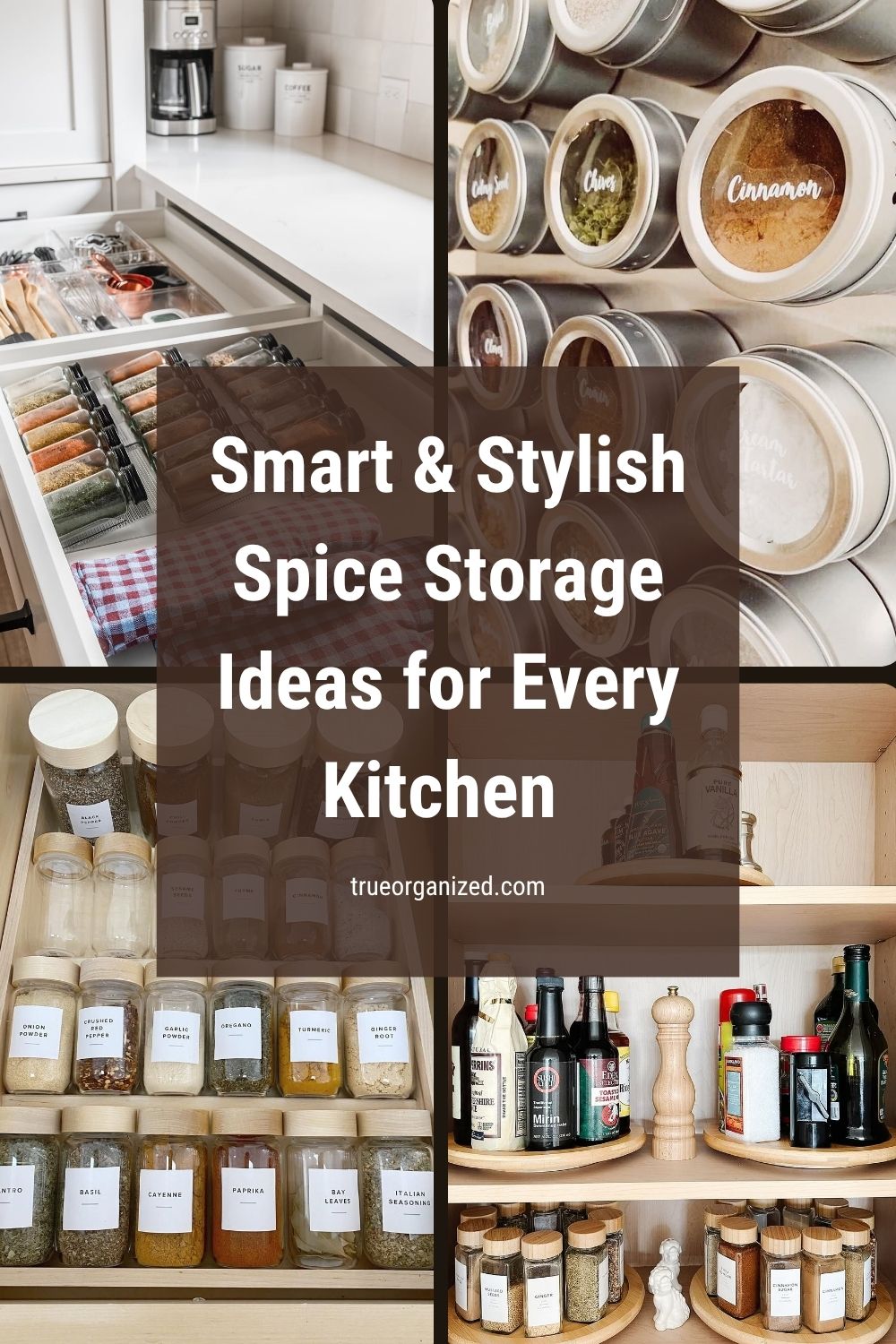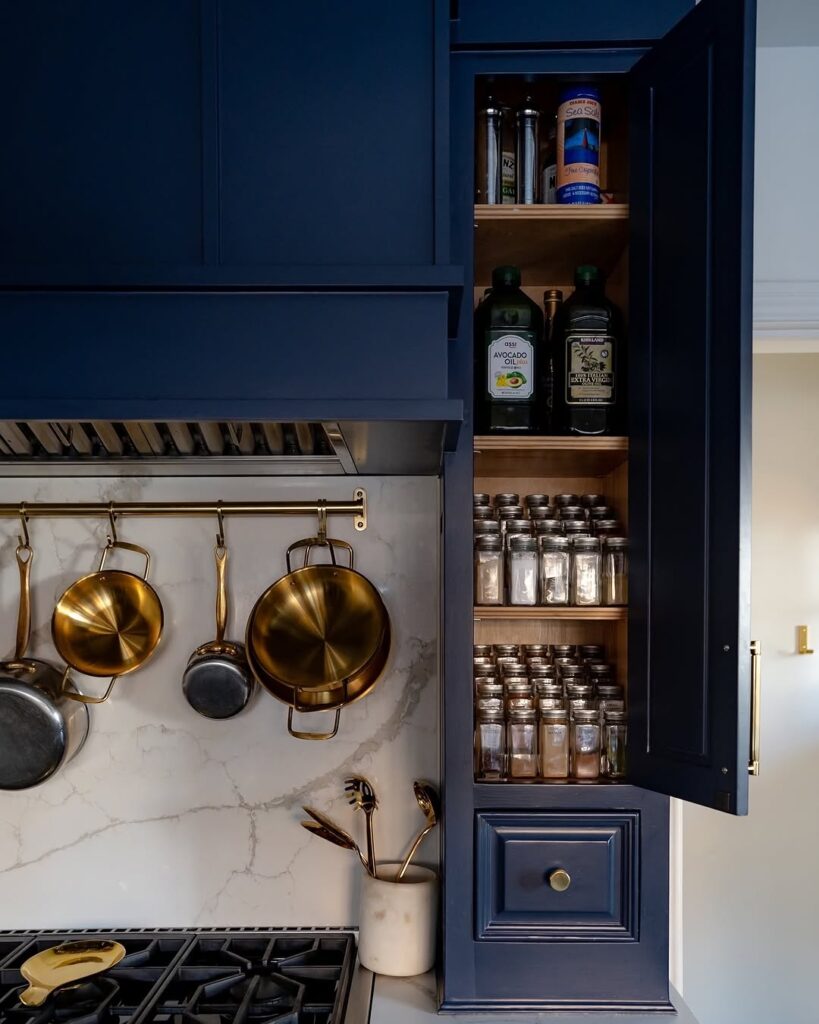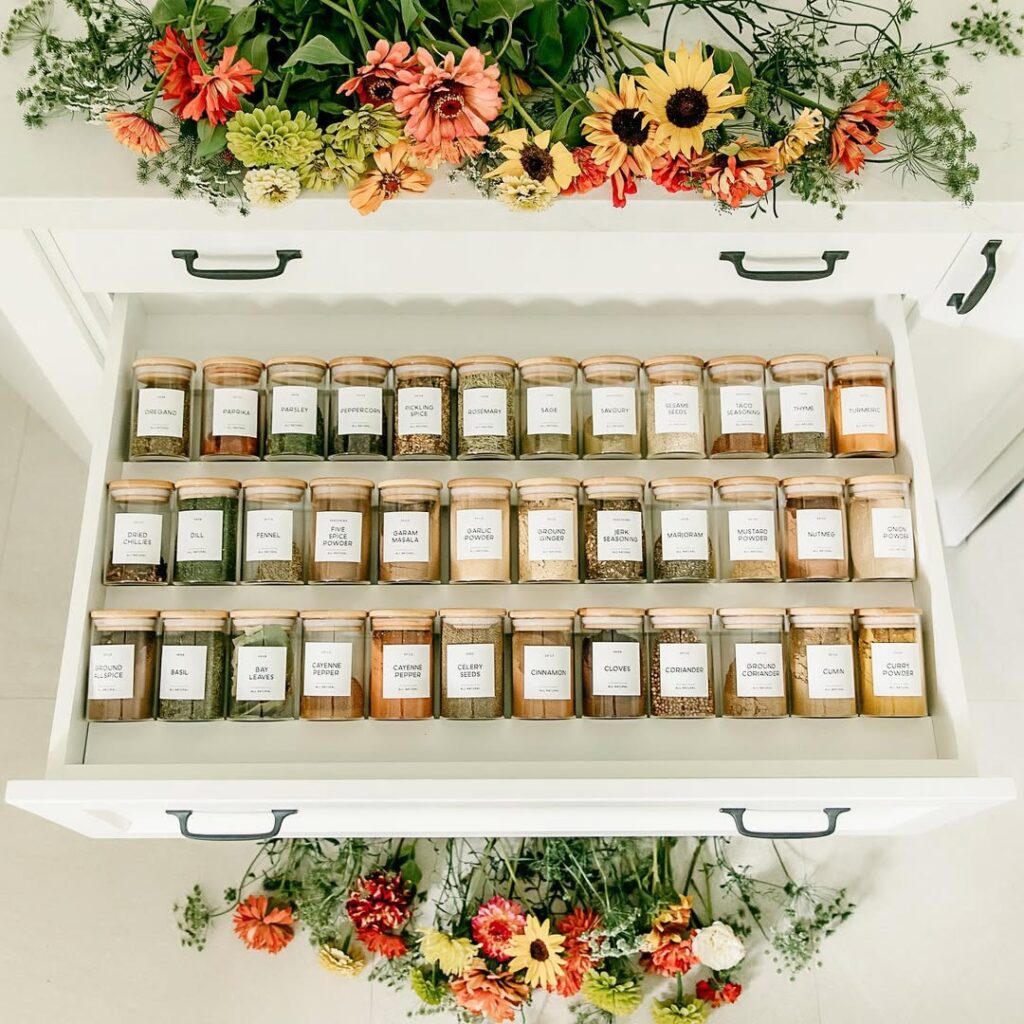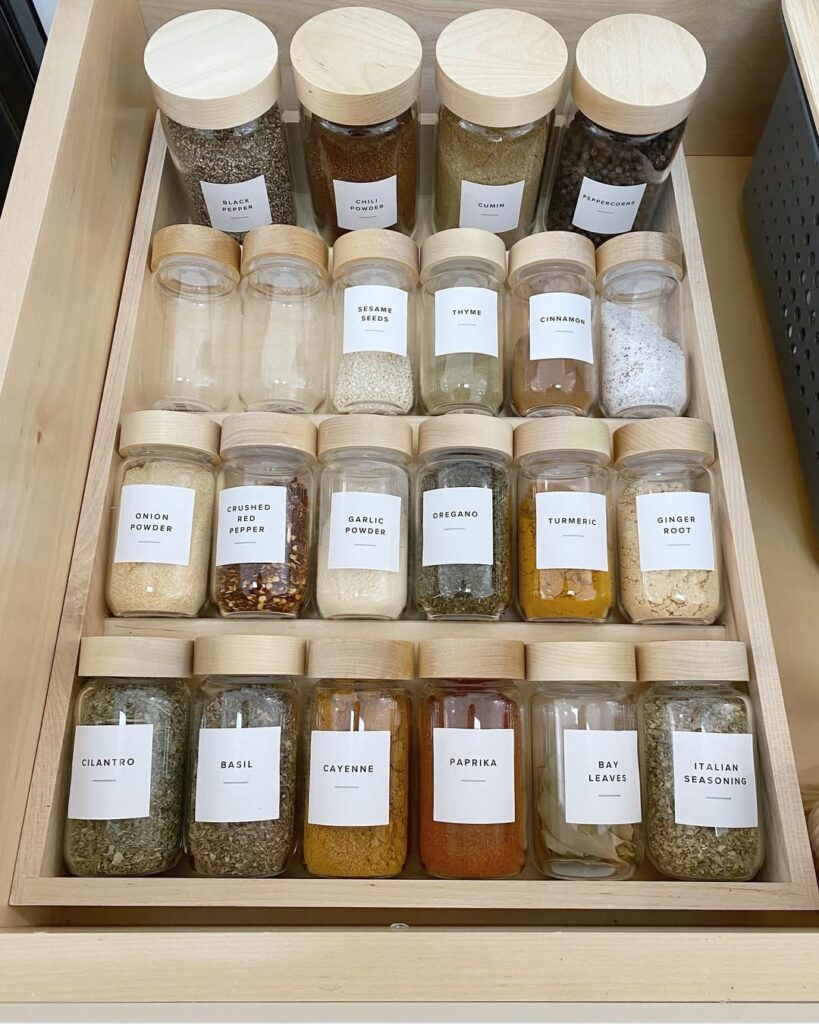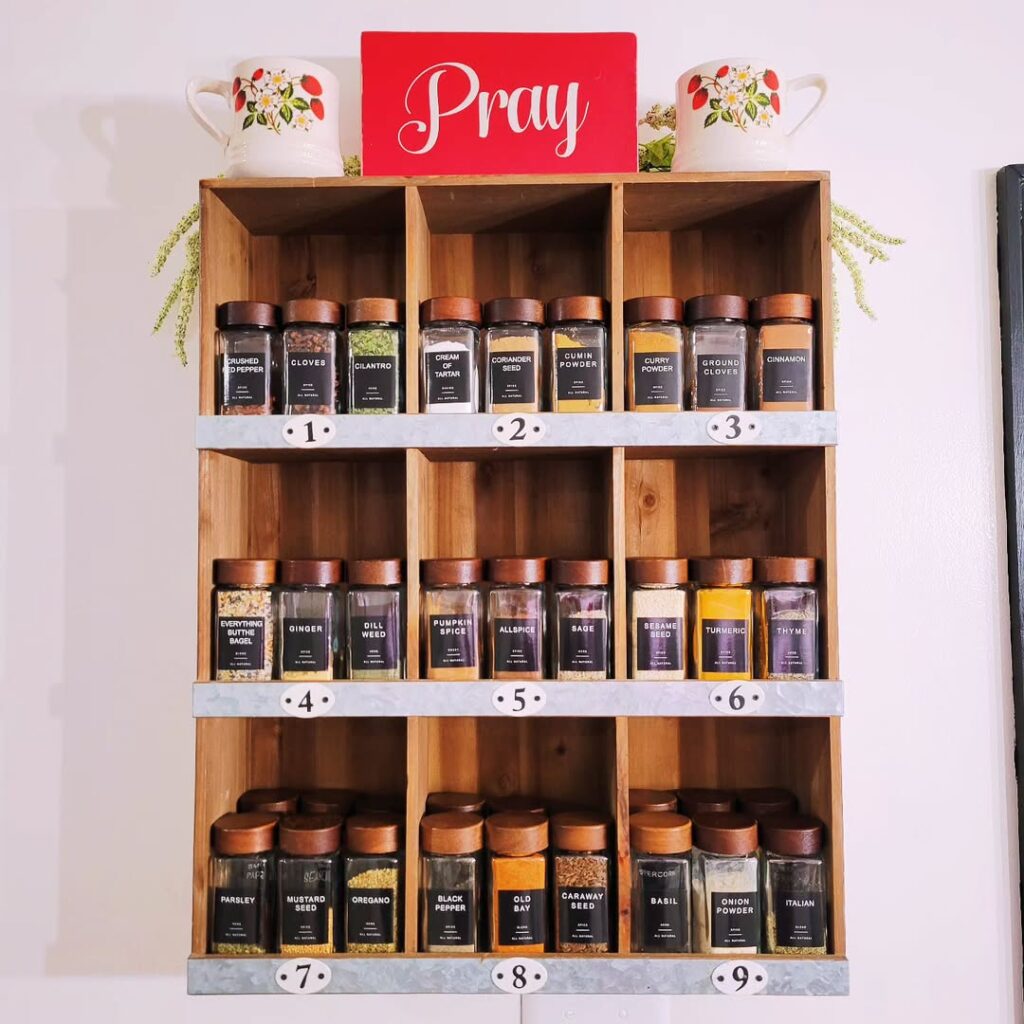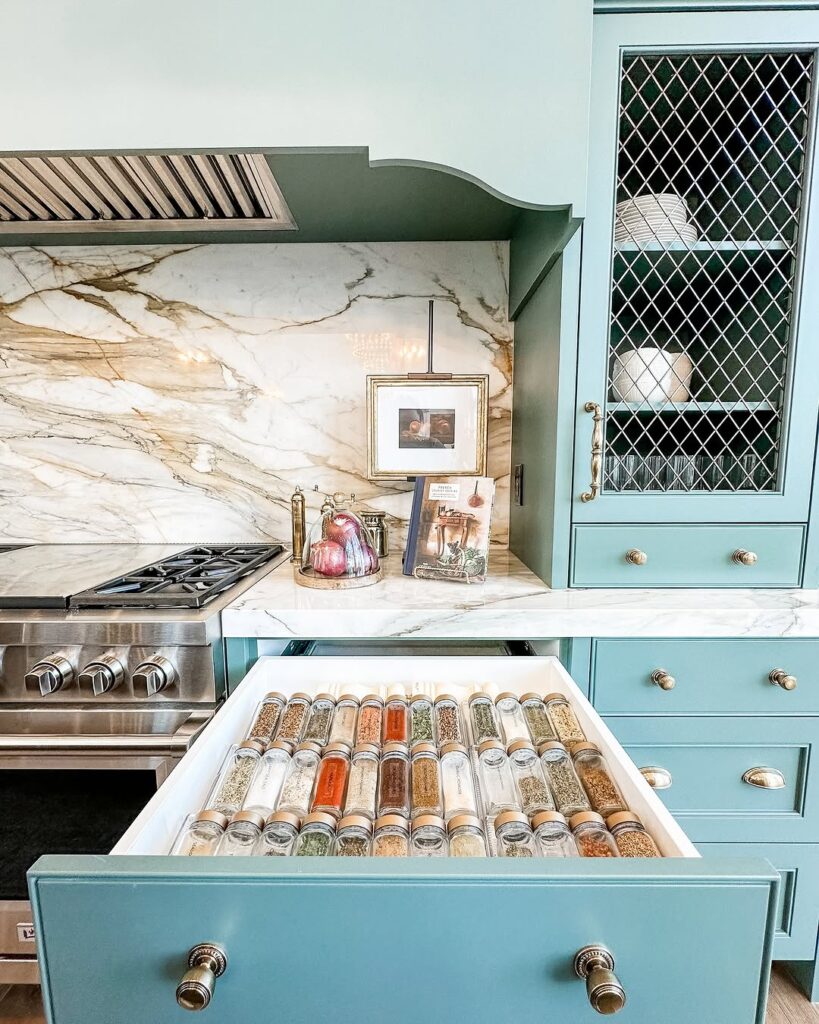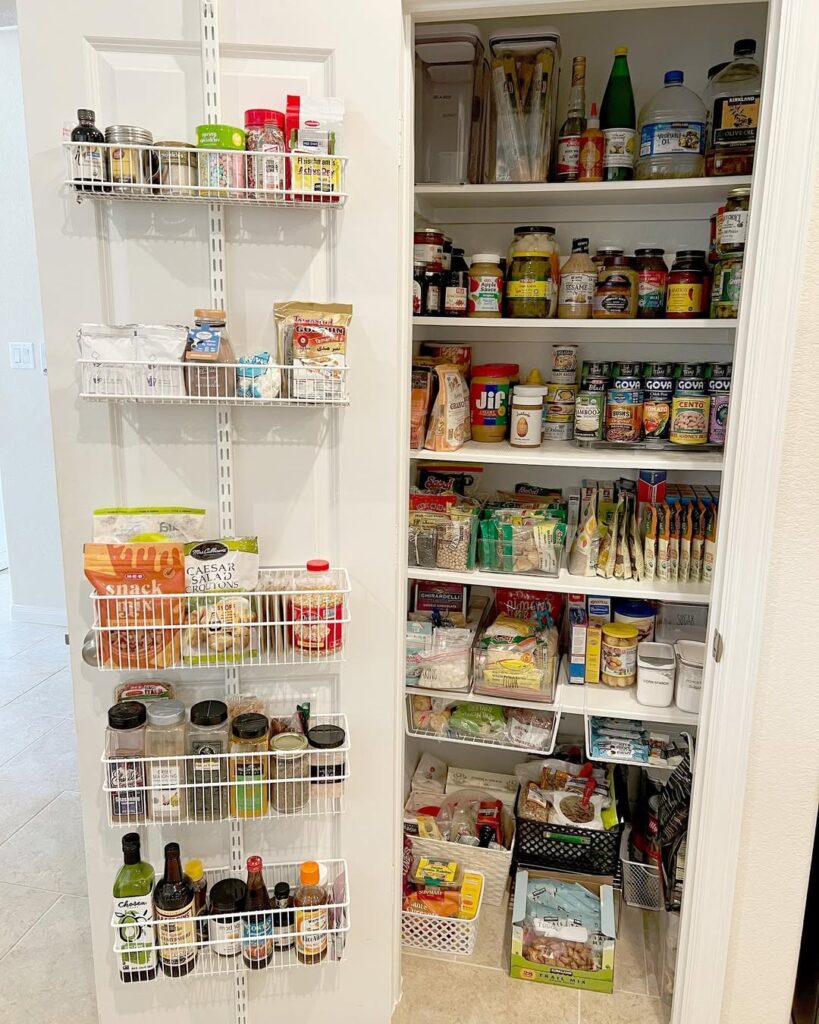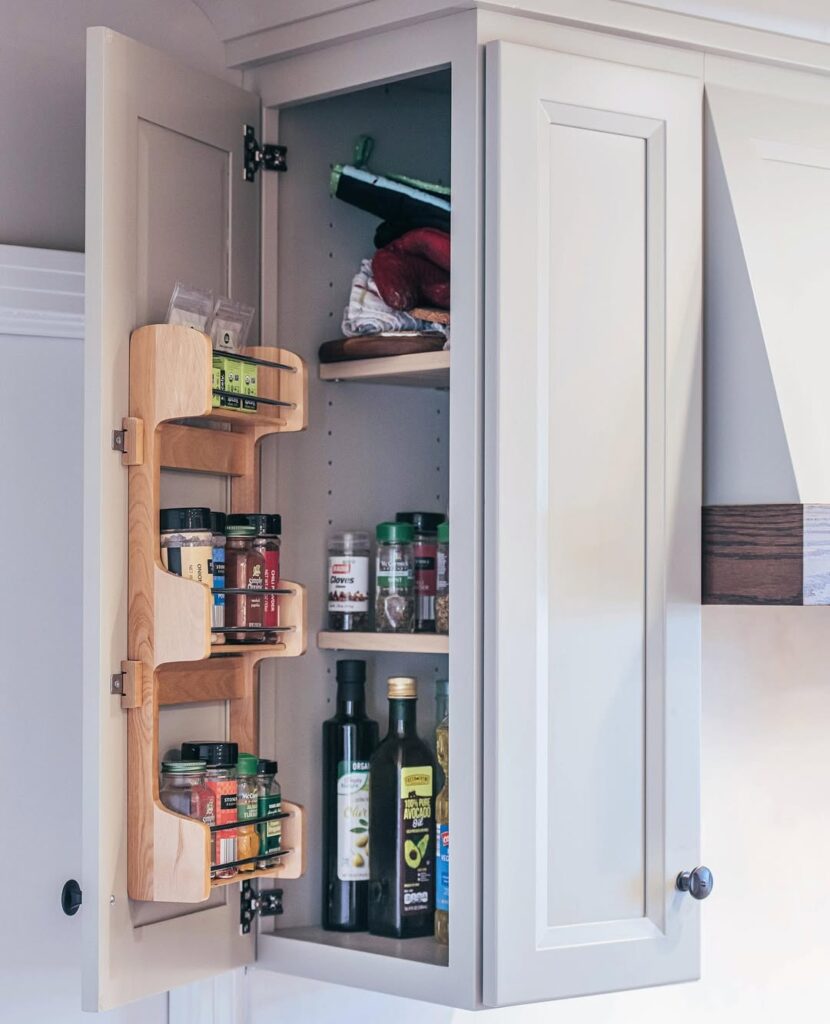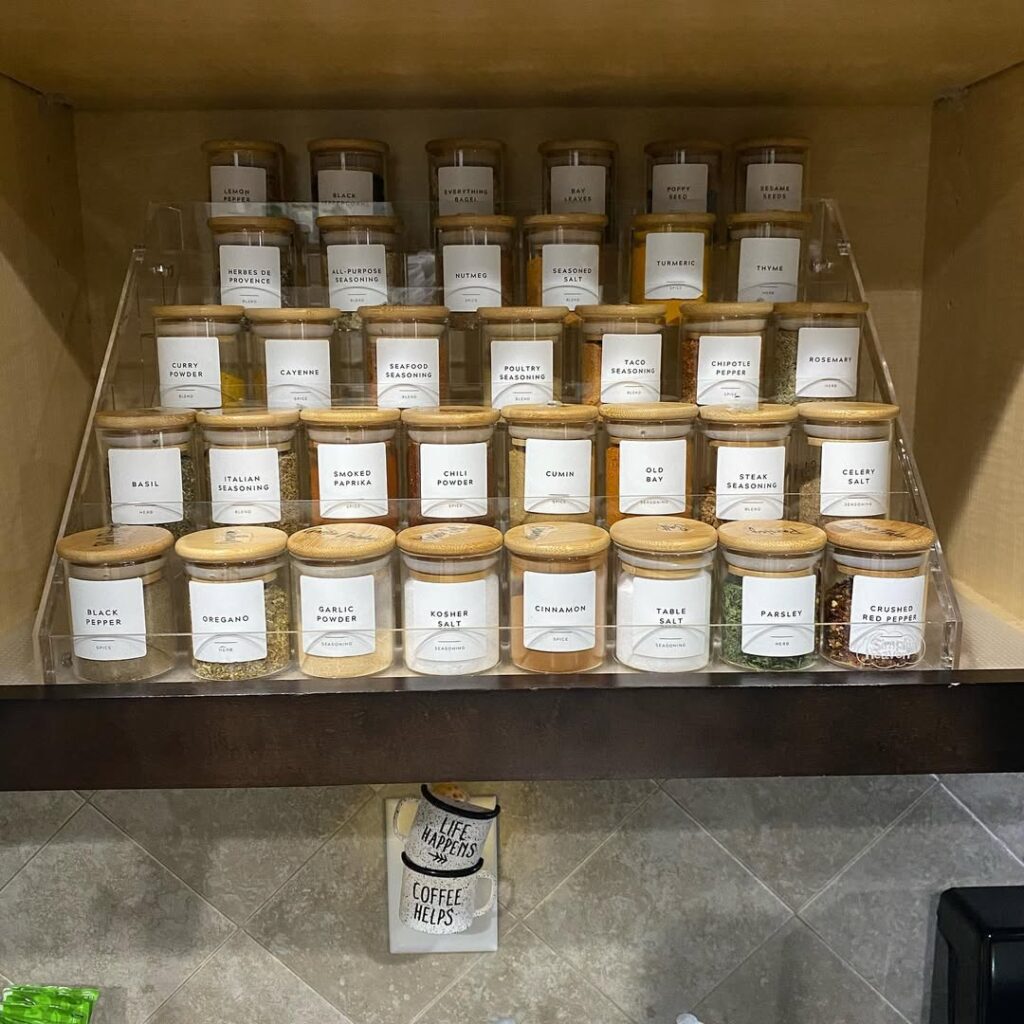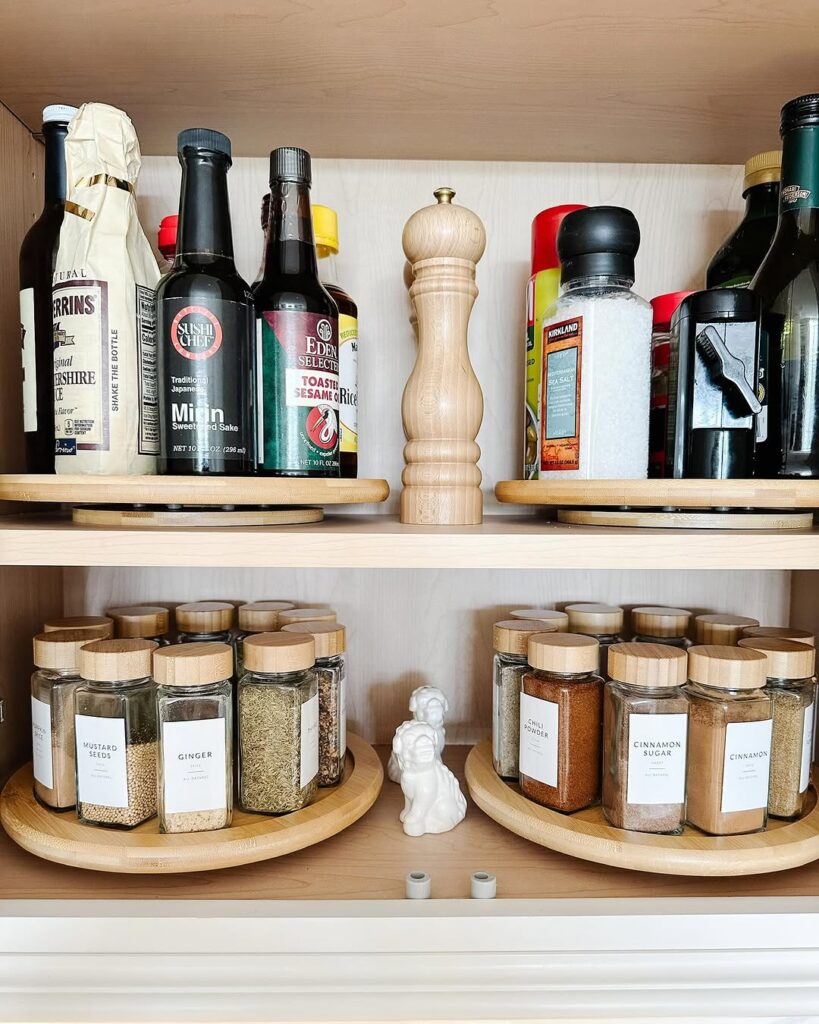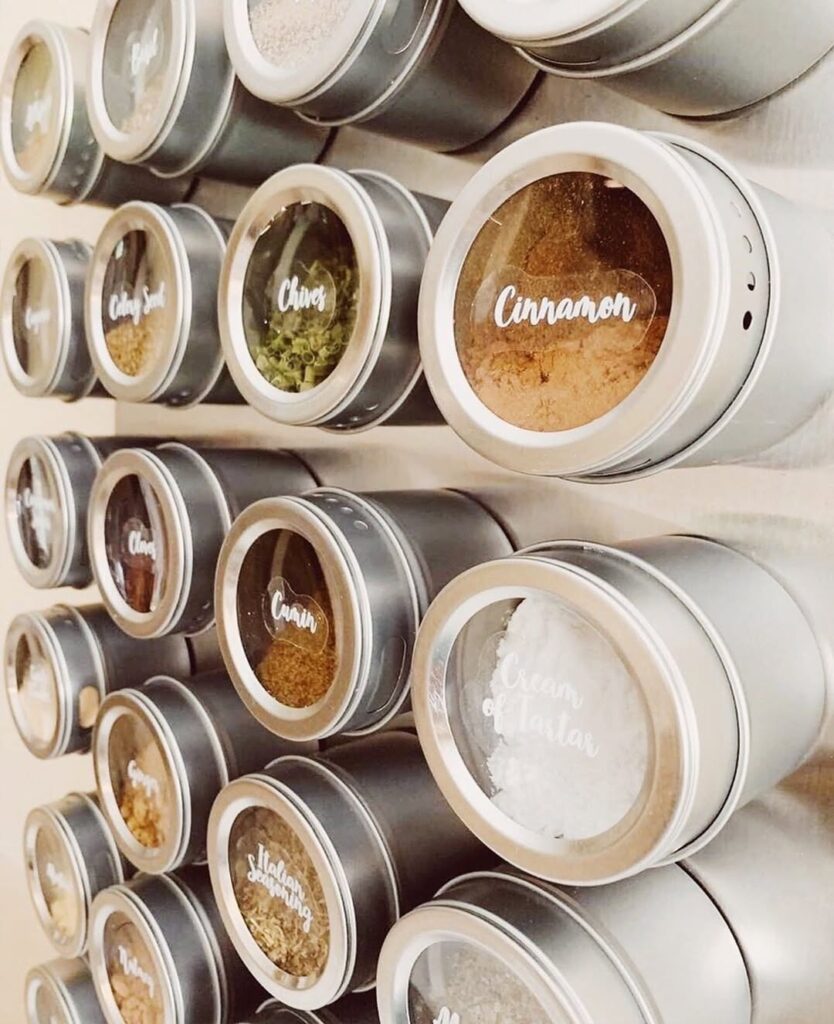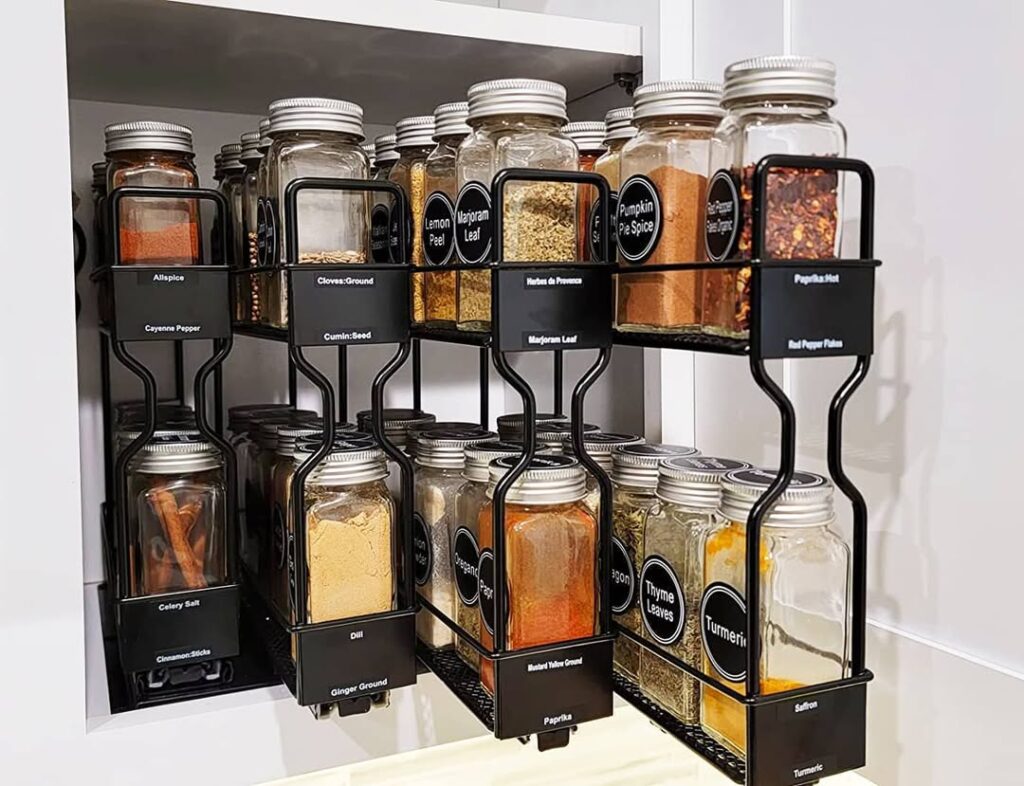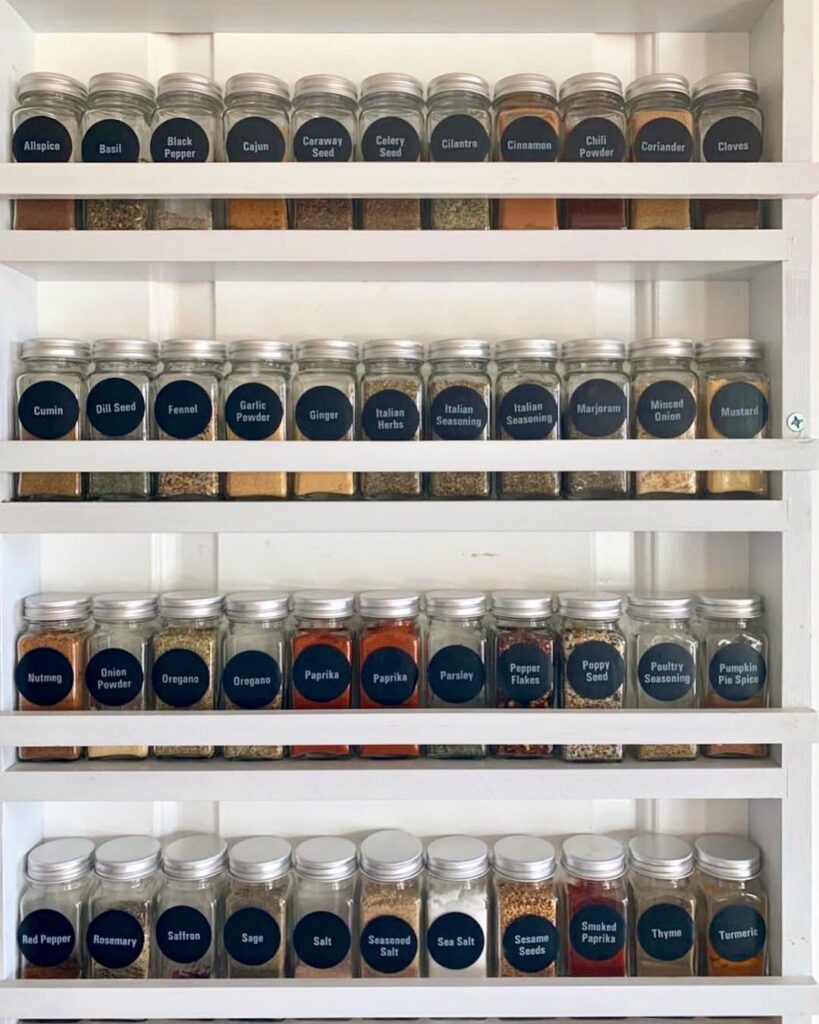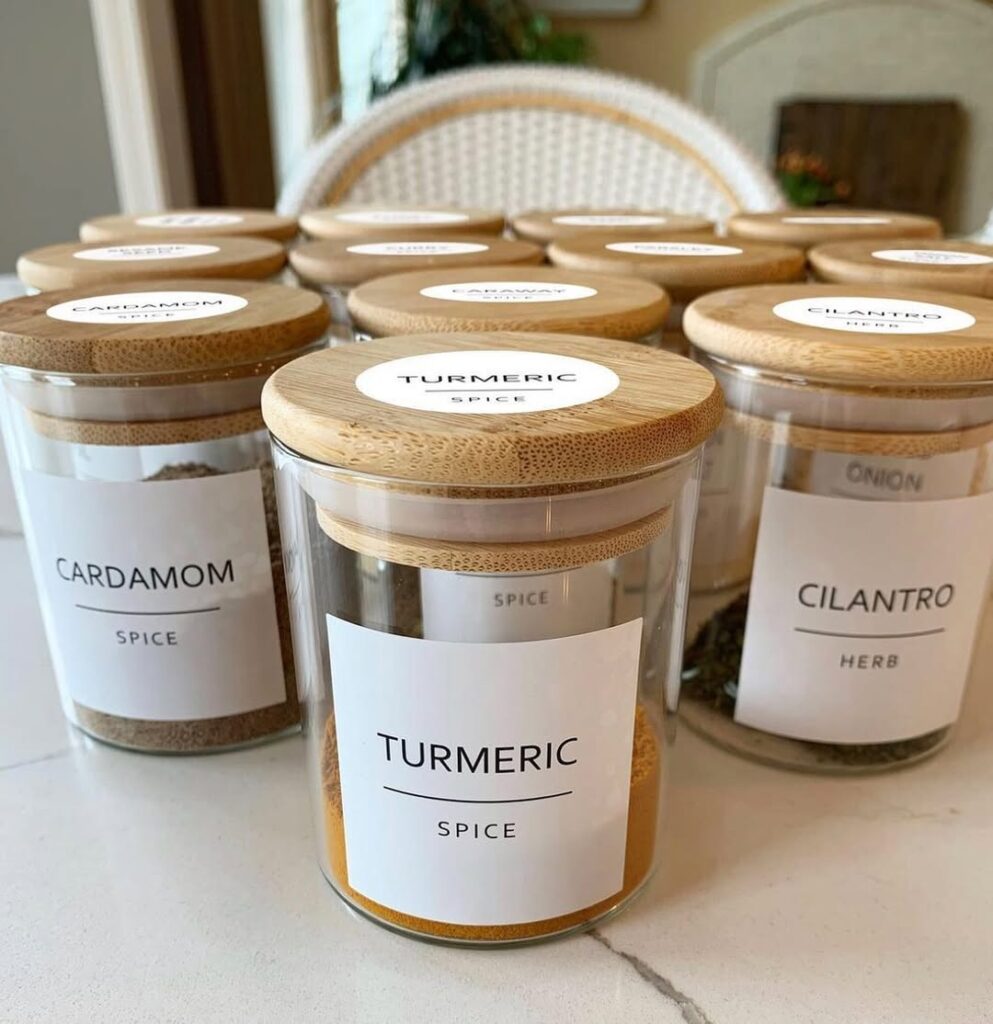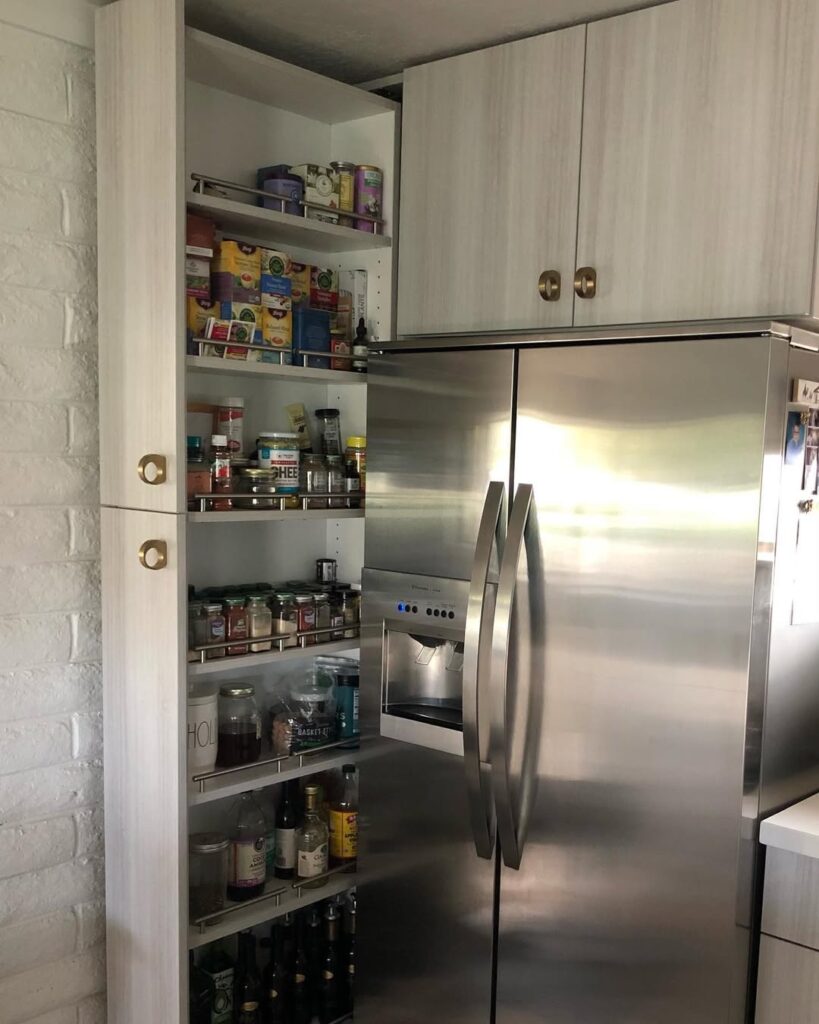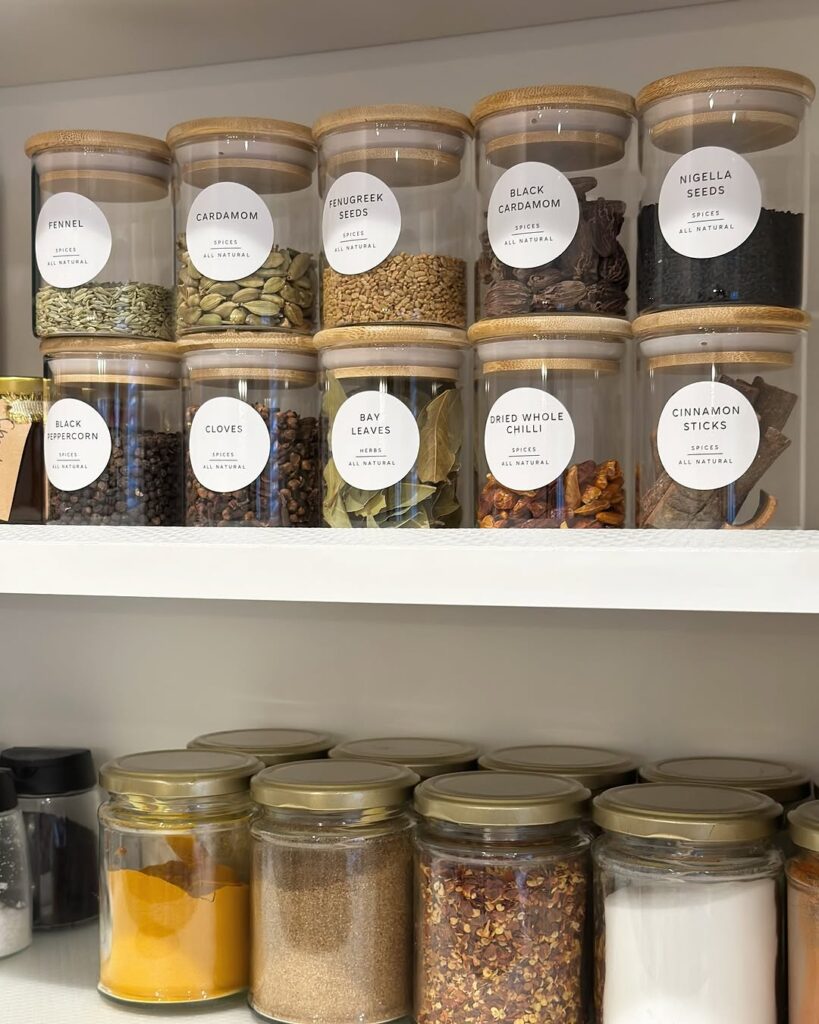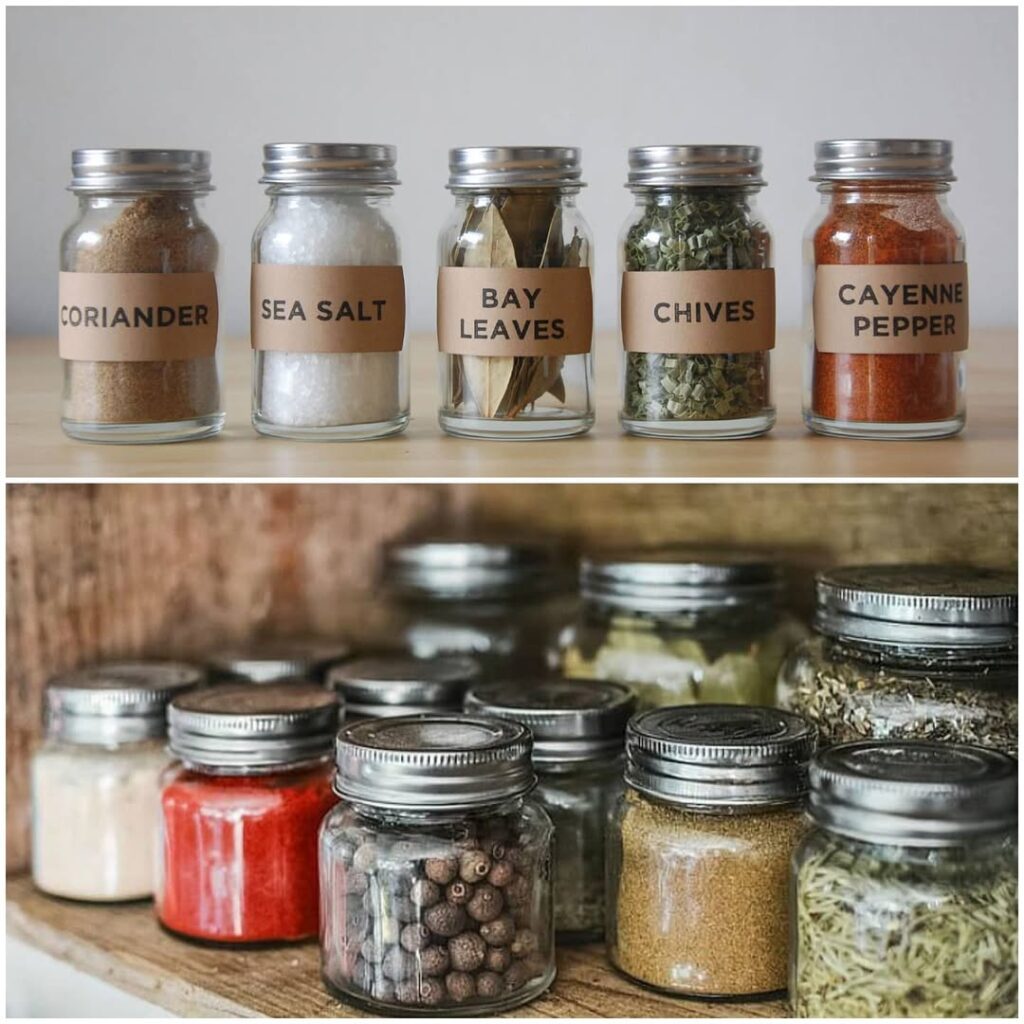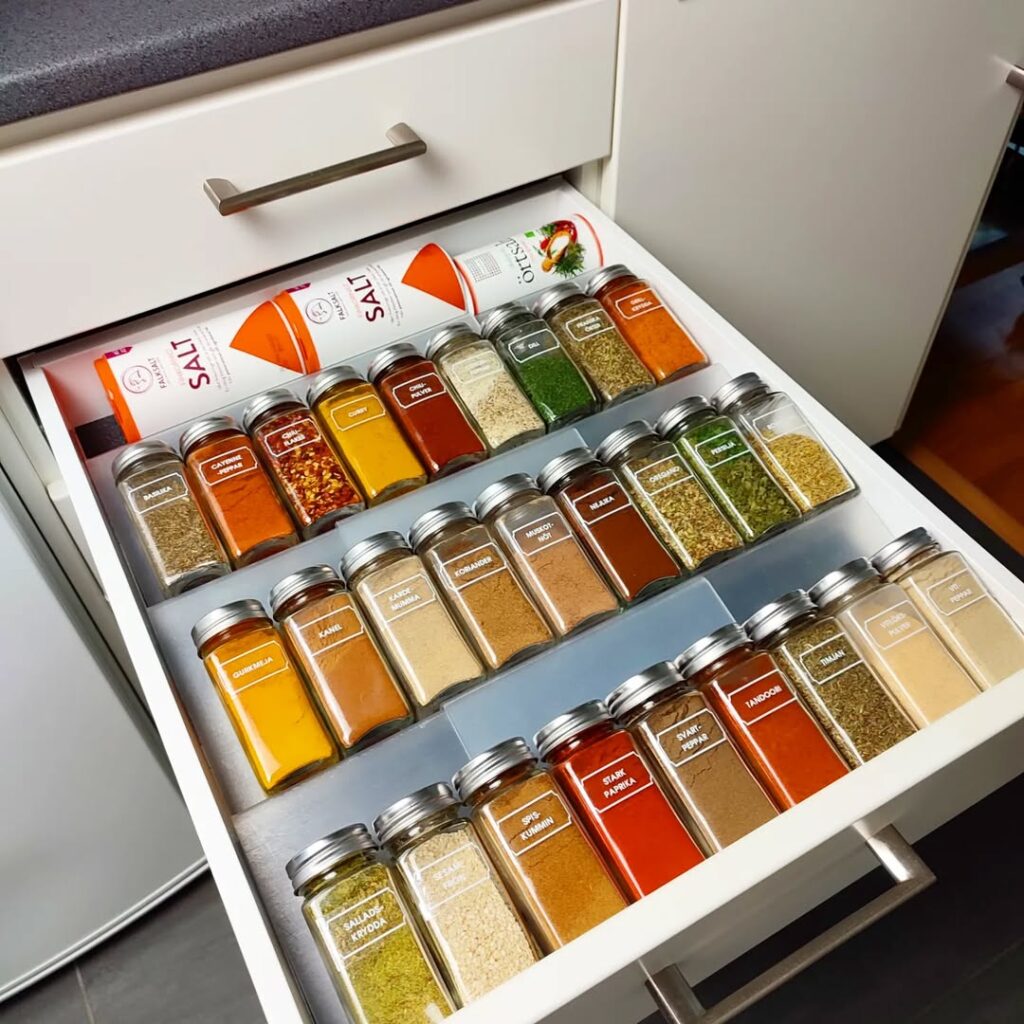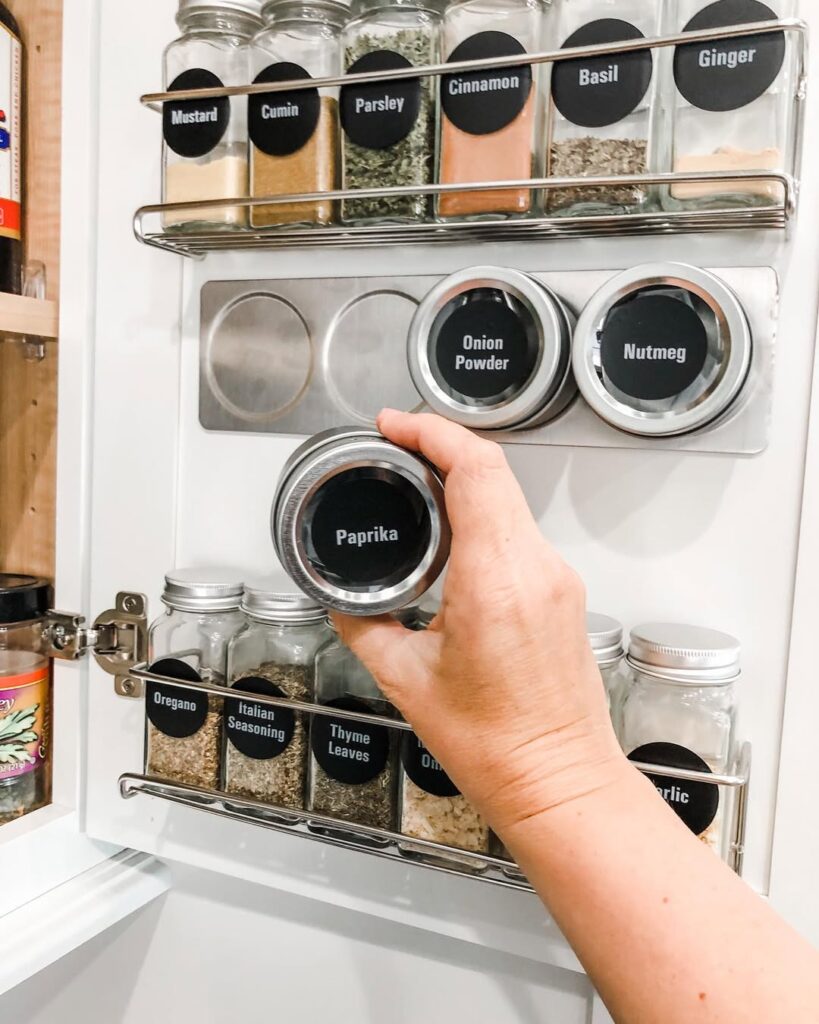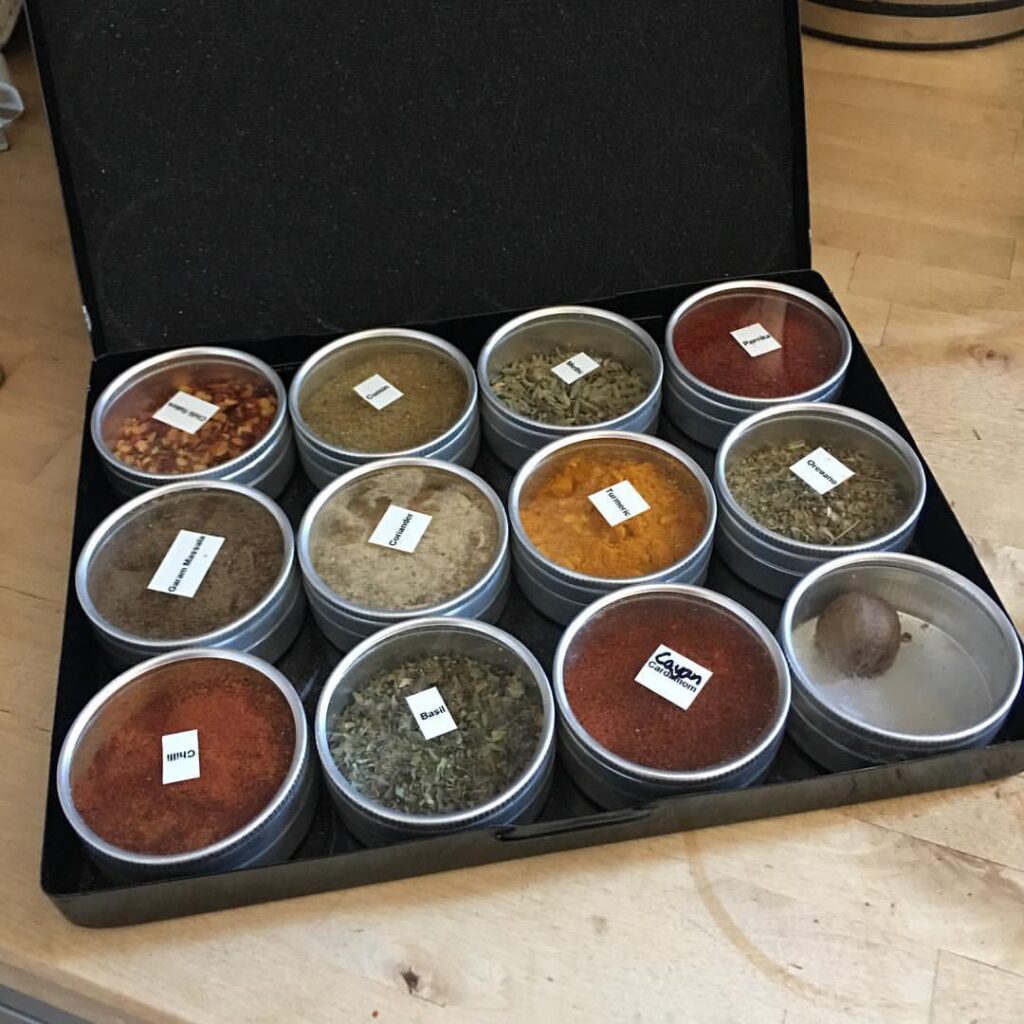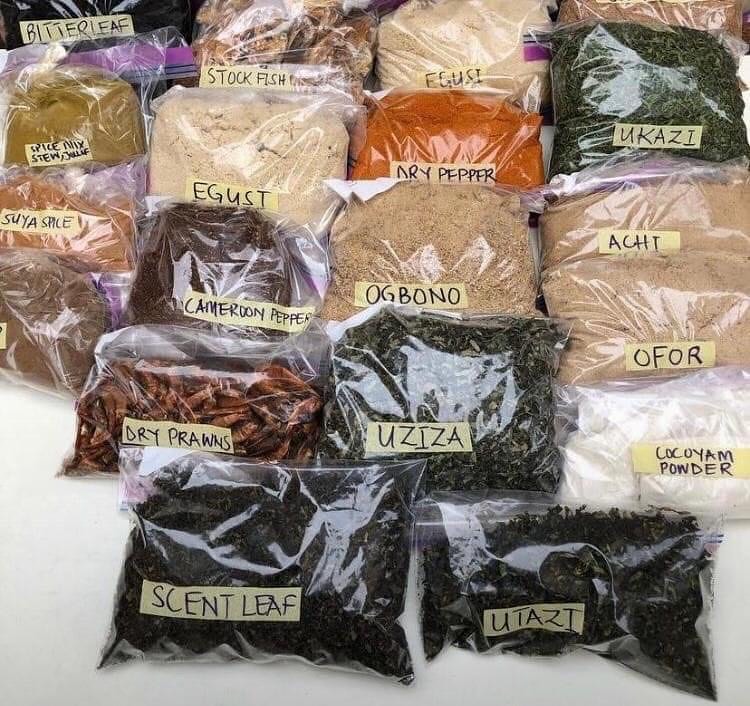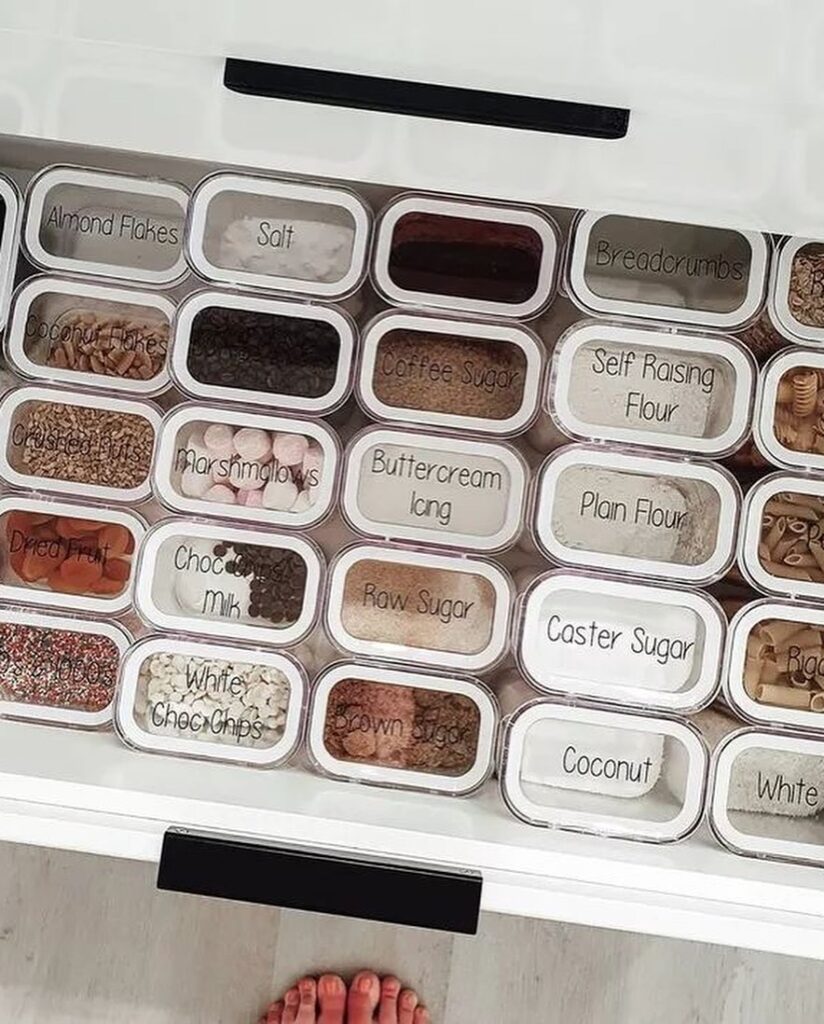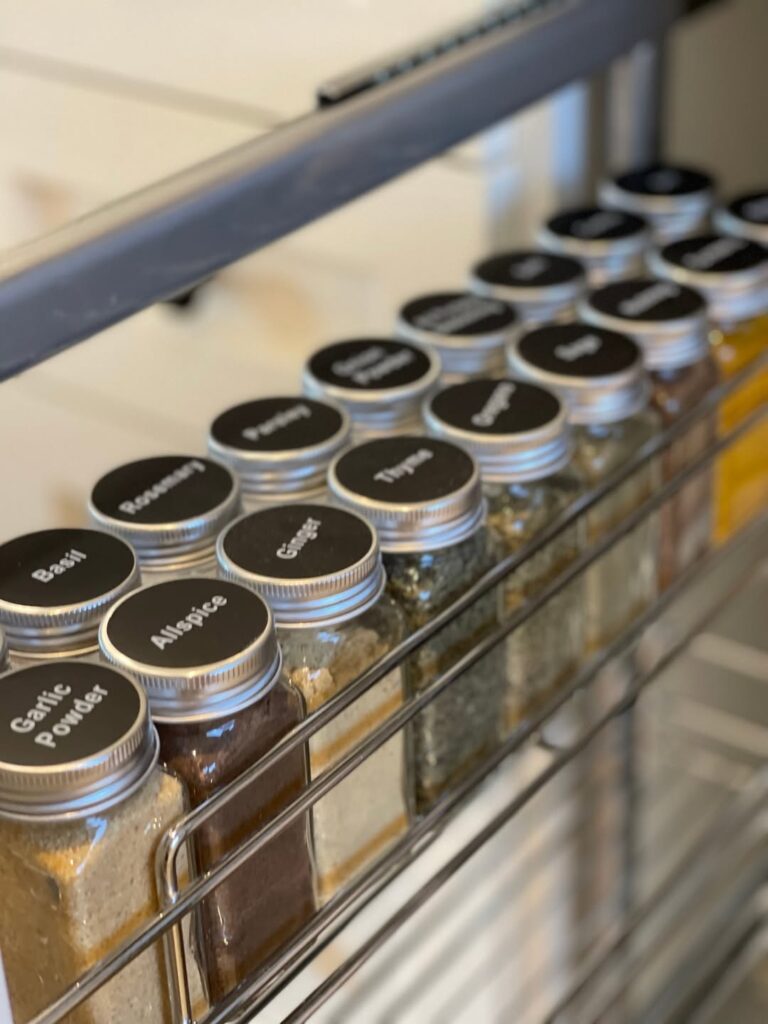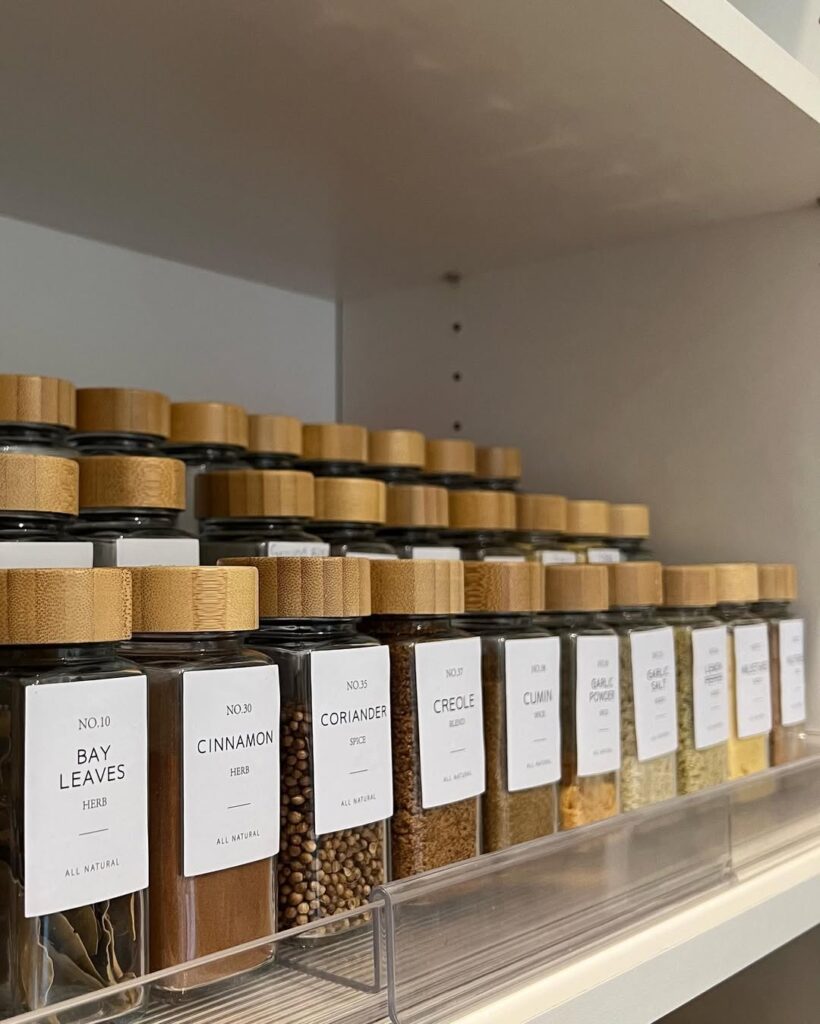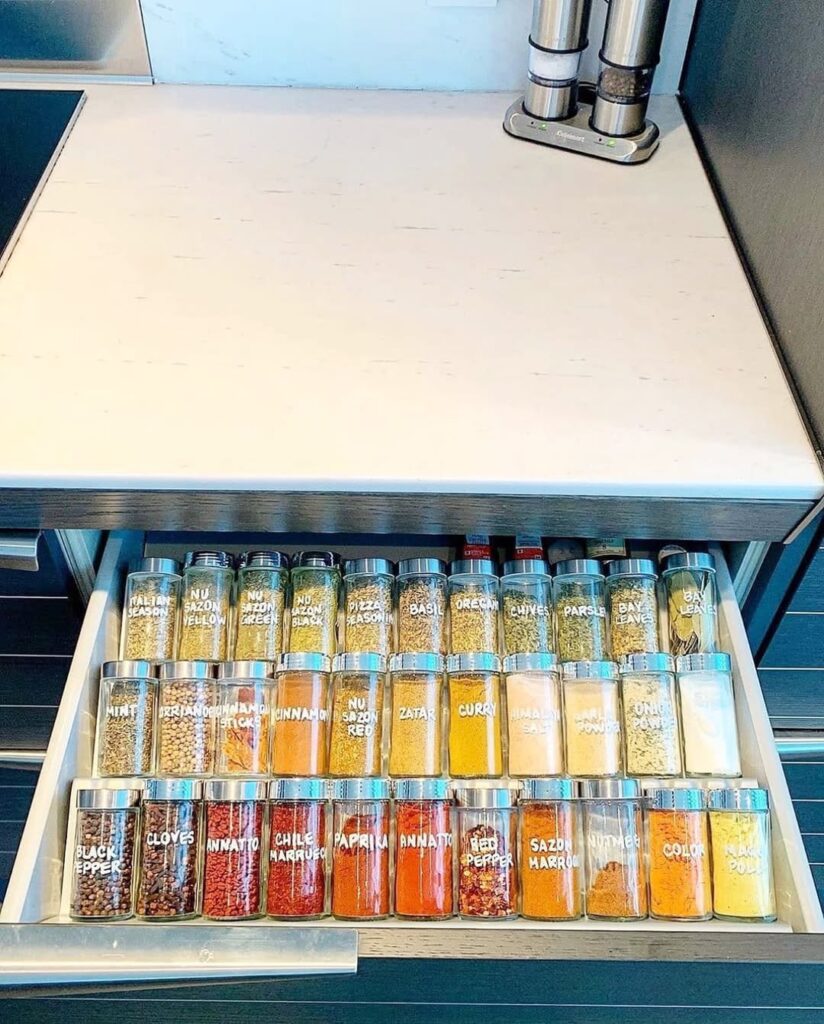Keeping spices neatly organized isn’t just about aesthetics—it saves time, reduces waste, and makes cooking more enjoyable. Whether you’re a gourmet chef or an everyday home cook, an effective spice storage system helps you find what you need, when you need it.
In this guide, I’m going beyond the basics to share smart, stylish, and practical spice storage ideas that actually work. From innovative drawer inserts to clever DIY hacks and pro-level pantry systems, I’ll help you create a setup that fits your kitchen, your cooking style, and your personal taste.
Contents
- 1 Why Spice Storage Matters
- 2 Types of Spice Storage: Definitions
- 3 1. Create a Spice System That Matches How You Cook
- 4 2. Optimize Vertical Space in Cabinets
- 5 3. Choose the Right Containers (And Why It Matters)
- 6 4. Standardize Sizes for a Cohesive Look
- 7 5. Drawer Spice Storage for Easy Access
- 8 6. Wall-Mounted Racks to Free Up Space
- 9 7. Utilize the Back of Cabinet Doors
- 10 8. Group by Alphabet or Category
- 11 9. Try a Lazy Susan for Deep Cabinets
- 12 10. DIY Magnetic Boards
- 13 11. Stackable and Modular Spice Systems
- 14 12. Label Like a Pro
- 15 13. Invest in Airtight Glass Containers
- 16 14. Hidden Pull-Out Cabinets
- 17 15. Pantry Zone for Bulk Spices
- 18 16. Repurpose Unusual Items Creatively
- 19 17. Smart Drawer Storage Solutions
- 20 18. DIY Wall-Mounted Spice Boards
- 21 19. Travel-Friendly Spice Kits
- 22 20. Freeze or Vacuum-Seal Rare Spices
- 23 21. Create a Baking Spice Zone
- 24 22. Keep an Inventory Sheet or App
- 25 23. Rotate and Declutter Your Collection
- 26 24. Incorporate Style Into Function
- 27 How to Maintain an Organized Spice Storage System
- 28 7 Common Spice Storage Mistakes (and How to Fix Them)
- 29 Final Thoughts
Why Spice Storage Matters
A disorganized spice cabinet can lead to:
- Duplicate purchases of spices you already have but can’t find.
- Expired spices that have lost flavor or potency.
- Frustration during meal prep when you’re trying to locate ingredients.
An effective system addresses all of this while enhancing your kitchen’s overall flow.
Types of Spice Storage: Definitions
To help you choose the best approach, here’s a quick breakdown of popular spice storage types:
Drawer Inserts
Special trays or risers designed to hold spice jars flat and label-side up within kitchen drawers.
Wall-Mounted Racks
Open racks that attach to kitchen walls or inside cabinet doors, ideal for saving space and quick access.
Lazy Susans
Rotating platforms often used in cabinets or on counters to make spices accessible from all angles.
Magnetic Containers
Spice jars with magnetic backs that stick to fridges or metal boards, saving counter and cabinet space.
Tiered Shelf Organizers
Stair-step organizers that elevate jars at the back for visibility and access inside cabinets or pantries.
Custom Pull-Out Cabinets
Vertical or horizontal pull-out drawers designed specifically to store spice jars neatly.
Over-the-Door Solutions
Rack systems or pockets that mount over pantry or cabinet doors, perfect for small or rental kitchens.
1. Create a Spice System That Matches How You Cook
Photo Credit: @lundhausstudio
Every kitchen is unique, and your spice storage should reflect your cooking habits. Whether you’re a minimalist or an adventurous chef, customizing your setup based on frequency of use and cooking style helps streamline meal prep.
- Group everyday spices together near the stove or prep area.
- Separate spices by cuisine type (e.g., Indian, Italian, Mexican) if you cook globally.
- Use refillable jars for bulk spices and store excess in airtight containers in your pantry.
2. Optimize Vertical Space in Cabinets
Photo Credit: @zahrasplace.co
Vertical cabinet space is often underutilized. By installing tiered shelves or pull-down racks, you can make the most of tall cabinets while keeping everything within reach.
- Use stair-step organizers to display labels clearly.
- Install undershelf racks or hanging shelves to double storage.
- Add pull-down or pull-out mechanisms for high or deep cabinets.
3. Choose the Right Containers (And Why It Matters)
Photo Credit: @claritythroughorganization
Spice containers affect not only how your spice rack looks but also how fresh your spices stay. Choosing the right material and size ensures your spices last longer and are easy to access.
- Glass jars are non-reactive and perfect for airtight storage.
- Magnetic tins work well for small kitchens and modern styles.
- Opaque ceramic containers help preserve light-sensitive spices like saffron or paprika.
- Avoid original packaging—they’re rarely airtight and tend to create clutter.
4. Standardize Sizes for a Cohesive Look
Photo Credit: @theknottsspotgardenhome
A uniform set of spice jars brings order to chaos. It makes your storage more functional and adds visual harmony, especially if your spices are displayed on open shelves or racks.
- Choose a consistent jar size to make labeling and stacking easier.
- Use graduated jar sizes only for frequently used spices like salt or garlic powder.
- Label lids or fronts uniformly with clear, easy-to-read fonts or printed tags.
5. Drawer Spice Storage for Easy Access
Photo Credit: @lundhausstudio
Deep drawers can be transformed into spice organizers with the help of angled inserts or tiered trays. This setup makes labels easy to read from above and keeps bottles from rolling around.
- Use bamboo or acrylic risers for a clean, custom look.
- Keep similar spices grouped together—baking, savory, spicy.
- Place the drawer near your main prep station for convenience.
6. Wall-Mounted Racks to Free Up Space
Photo Credit: @clearlycandace
If you’re short on cabinet or drawer space, a wall-mounted rack can be both functional and decorative. It’s a smart way to turn empty wall real estate into high-efficiency storage.
- Mount racks inside pantry doors or on unused walls near the stove.
- Opt for floating acrylic shelves for a modern, minimal look.
- Consider spice rails with lips to hold jars securely in place.
7. Utilize the Back of Cabinet Doors
Photo Credit: @you_neekdesigns
The inside of cabinet doors is prime real estate often overlooked. Lightweight racks, clips, or magnetic strips can transform this space into a hidden spice haven.
- Use adhesive-backed or screw-in mini racks for jars.
- Hang refill bags or small packets with curtain clips or binder rings.
- Make sure the setup allows the door to close completely without obstruction.
8. Group by Alphabet or Category
Photo Credit: @crayolakim
A little strategy in how you sort your spices goes a long way in saving time while cooking. Grouping alphabetically or by category helps reduce the hunt for specific seasonings.
- Alphabetical order is best for large collections you access frequently.
- Sort by category: sweet (nutmeg, cinnamon), savory (thyme, oregano), spicy (cayenne, chili).
- Color-code lids or labels for quick identification.
9. Try a Lazy Susan for Deep Cabinets
Photo Credit: @settlerhome
If your spice cabinet is deep and hard to navigate, a turntable (Lazy Susan) makes a huge difference. You can rotate it to bring hidden spices front and center.
- Choose a two-tier version to double capacity.
- Use rubber-lined surfaces to prevent jars from sliding.
- Perfect for corner cabinets or pantry shelves.
10. DIY Magnetic Boards
Photo Credit: @talentedkitchen
Magnetic spice boards offer a clever solution that’s equal parts functional and decorative. Mount one on a kitchen wall or inside a cabinet for a space-saving setup.
- Use small metal tins with clear tops and strong magnets.
- Label the bottoms or lids for quick identification.
- DIY with a metal sheet and chalkboard paint for a rustic-modern vibe.
11. Stackable and Modular Spice Systems
Photo Credit: @spaceaid_official
Modular spice racks are ideal for people with expanding collections. These systems are designed to grow with your needs and offer customizable layouts that suit any space.
- Choose stackable shelves that can be reconfigured over time.
- Look for brands that offer uniform jar sizes and refillable options.
- Some systems come with built-in label templates for consistency.
12. Label Like a Pro
Photo Credit: @talentedkitchen
Labels are essential—not just for aesthetics but for efficiency. Uniform, clearly legible labels help you spot what you need instantly and reduce cooking stress.
- Use waterproof, smudge-proof labels that won’t wear off with use.
- Choose between chalkboard, minimalist white, or clear label designs.
- Label both the tops and fronts of jars if stored in drawers or upright in racks.
13. Invest in Airtight Glass Containers
Photo Credit: @talentedkitchen
Original spice packaging is often flimsy and inconsistent. Upgrading to airtight glass jars helps preserve freshness and gives your spice storage a clean, unified look.
- Opt for glass jars with silicone seals and bamboo or metal lids.
- Round or square jars—choose based on your rack/drawer design.
- Avoid plastic, which can retain odors and degrade over time.
14. Hidden Pull-Out Cabinets
Photo Credit: @truewestcompanies
A slim pull-out cabinet can fit in tight spaces—like between your oven and base cabinets—and provide maximum storage in a minimal footprint.
- Ideal for new kitchen builds or remodels.
- Customize with adjustable shelves to fit jars of different heights.
- Include soft-close hardware for smooth operation.
15. Pantry Zone for Bulk Spices
Photo Credit: @ofselfandhome
If you buy in bulk, it’s smart to dedicate a zone of your pantry to spices. Store excess quantities in large jars or containers and refill smaller jars as needed.
- Use large, labeled canisters for cost-effective storage.
- Keep a funnel handy to make refills neat and easy.
- Include an inventory list so you don’t forget what you’ve stocked.
16. Repurpose Unusual Items Creatively
Photo Credit: @willowlarkdesign
Get inventive by using everyday items for spice storage—many of which you may already have at home.
- Test tube racks: A fun and sleek option, especially for modern kitchens.
- Baby food jars: Perfect for DIY magnetic lids.
- Vintage tea tins or apothecary bottles: Add charm and personality.
17. Smart Drawer Storage Solutions
Photo Credit: @izzy_organizing
If you prefer to keep your spices tucked away but still accessible, drawer storage is an excellent choice. It keeps spices protected from light and heat while offering easy visibility.
- Use slanted drawer inserts that keep spice labels visible.
- Choose shallow drawers to prevent jars from toppling.
- Store spices alphabetically or by cuisine to make selection quicker.
18. DIY Wall-Mounted Spice Boards
Photo Credit: @citygirlmeetsfarmboy
Create a functional yet decorative wall display using magnetic boards, pegboards, or wooden slats to mount spice jars or containers.
- Magnetic spice boards: Use tins with clear tops and strong magnets to attach to a framed metal sheet.
- Pegboard spice racks: Customize hook placement for a fully adjustable layout.
- Wooden slat shelves: Secure jars in place using elastic bands or individual grooves.
19. Travel-Friendly Spice Kits
Photo Credit: @connollyger
Ideal for campers, tiny homes, or picnickers, portable spice kits help you bring the flavor wherever you go.
- Choose compact cases with secure closures and refillable mini jars.
- Label the tops of containers for quick identification.
- Store kits in your car, RV, or backpack for outdoor cooking convenience.
20. Freeze or Vacuum-Seal Rare Spices
Photo Credit: @skybudgetlogistics
Preserve the potency of rare or infrequently used spices with proper storage methods.
- Use vacuum-sealing machines to protect spices from moisture and air.
- Freeze-dried herbs like parsley or dill stay fresher longer when kept in freezer-safe jars.
- Date each package so you can rotate stock appropriately.
21. Create a Baking Spice Zone
Photo Credit: @thehome_styled
Separate your baking spices from your savory blends to streamline cooking and reduce cross-contamination.
- Dedicate a section of your pantry or cabinet solely to baking essentials like cinnamon, nutmeg, cloves, and cardamom.
- Use matching jars and fun, vintage-style labels to give the zone personality.
- Include extras like measuring spoons, baking soda, and extract bottles in the same area.
Related Read: The Ultimate Baking Tool Organization Guide for Every Home Baker
22. Keep an Inventory Sheet or App
Knowing what spices you have on hand prevents you from overbuying and wasting money.
- Maintain a laminated spice inventory sheet inside your pantry door.
- Use apps like Sortly or Pantry Check to track usage and expiration dates.
- Group spices by cuisine or function (baking, grilling, everyday, etc.).
23. Rotate and Declutter Your Collection
Just like pantry staples, spices need regular rotation and editing.
- Check expiration dates twice a year.
- Smell and taste spices if you’re unsure of freshness.
- Discard duplicates and blends you rarely use.
24. Incorporate Style Into Function
Photo Credit: @theorganizedlife
A well-organized spice setup doesn’t have to be boring. Make it a part of your kitchen’s design.
- Choose racks or containers that match your aesthetic — modern, rustic, vintage, or minimal.
- Display spice collections in open shelving if they’re in decorative jars.
- Add a personal touch with hand-written labels or etched glass containers.
How to Maintain an Organized Spice Storage System
Photo Credit: @clutterproofresistance
Getting your spices beautifully organized is just the start — keeping it that way is where the real challenge begins. Here’s how to maintain your spice storage system effortlessly:
Regular Rotation & Expiration Checks
Even dried spices have a shelf life, and over time, their flavor fades. A well-maintained system includes scheduled check-ins to keep everything fresh.
- Check expiration dates every 3-6 months
Go through your collection and toss anything that smells weak or is past its best-by date. - Use the FIFO method (First In, First Out)
Always use older spices first and place newer ones behind or underneath to keep the flow organized. - Keep a small dry erase board or chalkboard
Use it to track spices you’re running low on — especially if you buy in bulk and decant.
Label Updates
Labels are a game changer, but over time, they might fade, peel, or become inaccurate.
- Invest in waterproof, smudge-proof labels
Especially if your storage is near the stove or sink. - Refresh handwritten labels when needed
Make sure names are still legible and spelling is consistent across jars. - Color code or number your jars
For a next-level system, assign categories like “baking,” “savory,” or “international” spices and group them visually.
Cleaning & Dusting
No one wants to reach for a jar and grab something sticky.
- Wipe down jars and shelves monthly
Especially in open shelving or magnetic systems that are exposed to cooking grease or steam. - Vacuum out drawer inserts
Loose spice particles or debris can collect over time in drawer ridges and inserts. - Sanitize lids and caps
Especially cork or bamboo ones that can absorb moisture — wipe them with a cloth dipped in white vinegar.
7 Common Spice Storage Mistakes (and How to Fix Them)
Photo Credit: @adetailedlife
Organizing your spice collection sounds simple, but it’s surprisingly easy to make mistakes that can affect both your kitchen’s functionality and your food’s flavor. Here are seven common spice storage errors to avoid—plus how to fix them.
1. Storing Spices Near Heat or Sunlight
It might seem convenient to keep your spices close to the stove or on a sunny windowsill, but heat and light are two of the biggest enemies of spice freshness. Prolonged exposure can quickly degrade essential oils in the spices, causing them to lose potency. To preserve flavor and shelf life, keep your spices in a cool, dry, and dark place—like a drawer, pantry, or dedicated cabinet.
2. Skipping Labels or Using Inconsistent Ones
Using unlabeled or mismatched containers can lead to confusion—especially when spices look similar, like cumin and coriander. If you’re constantly guessing or doing the “smell test,” it’s time to invest in a consistent labeling system. Uniform jars with clear, legible labels will make identification faster and more accurate while giving your spice setup a polished look.
3. Buying in Bulk Without a Plan
Large spice containers may be economical, but only if you use them regularly. Many people overbuy for a single recipe and never use the spice again. This leads to clutter and expired products. A smarter approach is to buy small quantities or share bulk spices with a friend. You’ll save space, reduce waste, and still enjoy variety.
4. Forgetting to Check Expiration Dates
Spices don’t spoil like perishable foods, but they do lose their aroma and flavor over time. An outdated spice won’t ruin your dish—but it won’t enhance it, either. Check your spices every few months, and do a full review at least once a year. If a spice has little to no scent, it’s time to toss and replace it.
5. Using the Wrong Storage Solution for Your Space
Not every spice storage system works in every kitchen. For example, countertop racks may look cute, but they can quickly overcrowd a small kitchen. Drawer inserts, wall-mounted racks, lazy Susans, and pull-out shelves are just a few smart alternatives. Choose a solution that fits your layout, lifestyle, and cooking habits for maximum efficiency.
6. No Organization System in Place
If you find yourself digging through jars every time you cook, you may need a better organization strategy. Randomly placing spices can slow you down and cause duplicates. Instead, organize alphabetically or by cooking category (e.g., baking, savory, international). A consistent system saves time and makes meal prep more enjoyable.
7. Ignoring Routine Cleaning
Spice storage areas often collect dust, crumbs, and spills over time. Neglecting to clean the space can make your setup look messy and may even attract pests. Wipe down your spice rack, drawer, or shelf monthly, and give everything a good clean-out seasonally. It’s a small task that makes a big difference.
Final Thoughts
Spices are a vital part of any kitchen — they elevate simple meals, enhance flavor profiles, and bring cultural variety to your cooking. But without proper storage, they can easily become cluttered, stale, or even forgotten.
By implementing a system that suits your cooking habits, space, and aesthetic, you’ll:
- Save time and reduce stress while cooking.
- Prolong the life and potency of your spices.
- Maintain a visually pleasing and functional kitchen.
Whether you go minimalist with drawer inserts or expressive with magnetic wall racks, the best spice storage idea is the one that blends organization with inspiration. Start small, experiment with what works for you, and enjoy a spicier, more efficient kitchen.

